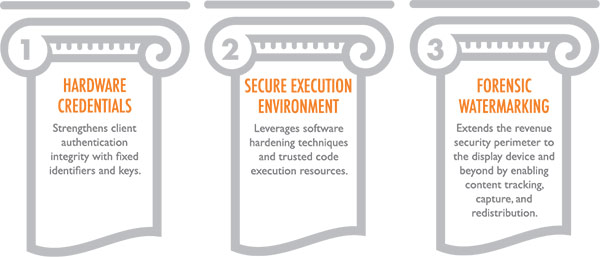UHD Services Demand a Secure Technology Ecosystem Approach

As consumer purchases of 4K-capable TVs have grown – and with true Ultra HD Premium models coming to market shortly – Strategic Analytics has predicted that almost half of all U.S. homes will have UHD TVs by 2020. It’s clear that the pent-up consumer demand for UHD premium video services is growing.
Smart content providers such as Bell Media, BT, Comcast, DIRECTV, Etisalat, Rogers, Sky, and Swisscom are seizing this opportunity by launching large-scale live sports content in UHD quality to their subscribers. But these are initial efforts in the start-up phase; for UHD premium video to fully realize its market and profit potential, the content distribution industry needs to implement an end-to-end UHD TV premium technology ecosystem. Such an ecosystem would not only encompass the specific playout, delivery, and viewing elements of UHD premium, but also the security measures required to keep this content secure, and operator revenues protected from a new range of threats.
“Ultra HD is a technology that will revolutionize the world of video,” said Thierry Fautier, Ultra HD Forum President/Chair and Harmonic’s VP of Video Strategy, in an online chat recently, with CTOi Consulting’s Ben Schwarz. “Making UHD requires a complete rethinking of the workflow, from video capture to production to the presentation.”
There are two main technological ecosystems in play for UHD premium content distribution, one for real time (live broadcast) and the other for non-real time (video on demand/episodic content). Implicit in both architectures is the requirement for security elements to protect the signal path from hacking, so that the content going from end-to-end is not intercepted and exploited by pirates.
Of course, these are idealized views of UHD premium TV delivery. The challenge facing UHD premium TV distributors is to select and implement specific UHD technological ecosystems using actual software/hardware platforms. “Harmonic, [and] a group of 40 other companies, have created the Ultra HD Forum to take care of the complete UHD chain from end-to-end, including OTT, QoS, Push-VoD, nVOD, adaptive streaming, live, and on-demand,” says Fautier, indicating in a recent blog that there are definitely a lot of smart people working on solutions.
Part of the picture that emerges is the need for a security solution that integrates seamlessly with the other components of a UHD ecosystem, such as VCAS (Verimatrix Video Content Authority) Ultra. Built upon the three pillars of hardware-based security, trusted software security, and digital watermarking, VCAS Ultra provides content distributors with a UHD revenue security solution that addresses the vulnerabilities inherent in the system, plus the ability to authoritatively identify the source of pirated content when it does appear.

Three Pillars of UHD Security
Multichannel Newsletter
The smarter way to stay on top of the multichannel video marketplace. Sign up below.
Verimatrix has taken this a step further through its focus on the whole ecosystem rather than individual components in isolation. For example, we recently unveiled our Ultra Security certification program, which enables components, including set-top boxes in UHD ecosystems, to meet the strongest security requirements specified by premium rights holders and, in particular, the MovieLabs’ Specifications for Next Generation Video and Enhanced Content Protection. In turn, the program will give pay-TV operators the assurance that consumer devices they select for UHD really are compliant with the guidelines that have emerged in response to the concerns of major rights holders.
If any of the three pillars of security are compromised, the program will protect the entire system from being successfully hacked. Ultra Security combines the resistance to attack enabled by hardware with the flexibility and upgradeability of software, so that the whole system can be updated as required to accommodate changes in both the industry and security requirements for different types of premium content.
The bottom line: A UHD technology ecosystem is only as strong as the integration of the different infrastructure components. Active participation of both SoC and device makers is critical for ensuring the three pillars of the UHD security model, and has emerged as the gold standard that actually delivers the expected level of protection.
To learn more, please download theMultichannel Newsebook, “Protecting the Ultra HD Premium TV ‘Golden Goose’”
Additional Resources
The Future of Revenue Security for Ultra HD Video
This is a detailed look at the three pillars (hardware-based security, trusted software security, and digital watermarking) of effective UHD content security. It explores how the three pillars work together to deter hacking, and identify those hackers who succeed in pirating content quickly and reliably.
Verimatrix VCAS Ultra – The Future of Pay TV Revenue Security
This video explains the thinking behind Verimatrix’s VCAS Ultra UHD protection suite, and how it enables content providers to protect and monetize their UHD premium services.
Perfect Storm of OTT and UHD Raises Bar for Pay TV Security
This Verimatrix blog examines the various issues associated with successful UHD content provision. Topics explored include trends in UHD feature development, UHD chipset security certification and why it matters, and OTT/UHD content protection on the pirate-prone Web.
Integrated Watermarking Creates More Profitable Pay-TV Businesses
This document explains how integrating watermarking ‘invisibly’ into digital content makes it far easier to identify pirated material, where it was pirated from, and who likely pirated it; making watermarking a useful tool for investigators.
